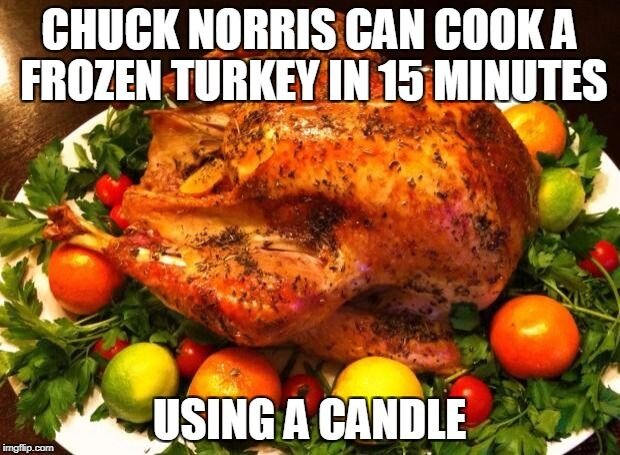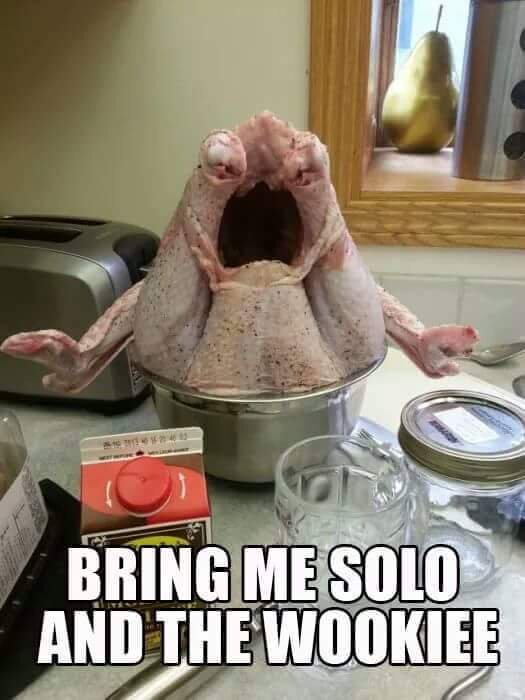Turkey-Cooking Hacks: Top Carnivore Style
So many people are intimidated by cooking the Thanksgiving bird. There are probably more Turkey roasting recipes than there are embarrassing Thanksgiving dinner stories. At the height of the season, we get more calls asking for cooked turkeys, than for anything else. When we tell guests that we only sell raw, you can hear the dread in their voices as reality sinks in. But being responsible for baking that bird doesn’t have to be a burden. A few hacks we’ve learned over the years—and a detailed recipe at the bottom of this post—should help you get through the big day. It helps to have a nip of “kitchen helper” bourbon if you start to panic.
Seasoning
Starting with seasoning is key because it really is the Achilles Heel of cooking. It’s shocking how one of the simplest tasks in cuisine can be the only difference between a delicious meal in a well-known restaurant, and the bland plate you have to choke down at Grandma’s house every year.
When it comes to whole animal cooking, it’s especially hard to thoroughly season your proteins. That’s why we recommend brining your bird for at least 12 hours before you bake it. Dunking that gobbler in a saline solution (90 minutes per pound for no more than 24 hours) allows the bird to really soak up that flavor. If you add aromatics like rosemary, garlic, cloves, or juniper berries to your brine, those salt crystals will have the added bonus of carrying Holiday smells deep into the bird.
Hack #1: When making your brine, don’t forget to quickly boil the water before adding the salt and aromatics. This allows the salt to completely dissolve into the liquid and not settle at the bottom. Before the brine cools, add the aromatics to make a “tea” that will infuse your turkey (don’t worry if the water starts to discolor). You can also add half a cup of sugar, honey or maple syrup to intensify the saltiness (I know it sounds backwards, but it works).
Roasting
Let’s get down to business. Roasting our Diestel Farms birds is pretty straight forward, although there are lots of steps. This may seem like a lot of fuss, but remember, you probably are only cooking this gobbler once or twice a year, so stop complaining and get cooking.
Hack #2 Temper..temper…temper. No, I’m not talking about coping with the In-Laws. The real secret to making sure that bird isn’t under/overcooked is to temper. Time and again, life gets in the way of good cooking and folks forget to let their meats come to room temperature before throwing them in the oven. Germaphobes, listen up! You’re more likely to get salmonella from an undercooked bird than an over-tempered one. Let that turkey rest on the counter for AT LEAST two hours before putting it in the oven. This ensures no pink parts when it comes out of the oven.
Hack #3 One last hack before you roast, separate the skin. This is a trick we learned from a Peking Duck chef who would inflate his whole birds with a bicycle pump. If you separate your turkey skin from the breast and leg meat with a gloved hand, you’ll get super crispy skin. The added space is also just begging to be crammed full of compound butter (available at ECB) adding a whole other county to flavor country.
Hack #4: Basting=browning. A lot of people complain about basting because it slows the cooking time. However, I find it evens out the browning process, and ensures moist white meat (an elusive achievement in turkey cooking). My favorite basting liquid is a bottle of cheap Chablis and a stick of butter. Keep the liquid in a pot on the stove (hot but not boiling), and add a few squirts every 20 minutes to the bird. After two hours, the pot should be empty with the entire contents in the roasting pan. If it’s a big bird, continue to baste from the drippings in the roasting pan every time you check the temp.
Hack #5: Finally, when your bird reads 160 degrees on your trusty digital thermometer (NO “buttons” or analog temp gauges allowed) it’s time to take it out of the oven. But WAIT! You have to rest the meat before you carve. Account for at least 30 minutes of resting to let the bird finish cooking, and the meat to retain any remaining moisture. Otherwise, you’ll be burning your hands carving through your bird while all that delicious liquid you worked so hard to lock in, dribbles off the cutting board and onto the floor.
The entire recipe is below. Remember, just have fun. And don’t forget, every good meal starts with good ingredients. Our GAP-5 Diestel Farm Turkeys are the best in the OC.
Good Luck!
Ingredients for Brining
1 Diestel Farm Turkey, giblets and neck removed
2 gallons water, divided
2 cups kosher salt
½ cup sugar, honey, or maple syrup (optional)
2 ounces fresh ginger, sliced
2 sprigs fresh rosemary
2 sprigs fresh thyme
2 sprigs fresh sage
8 allspice or juniper berries
4 whole cloves
1 TBS whole black peppercorns
Ingredients for Roasting (Basting):
1 ECB Compound butter
1 bottle Chablis or dry white wine
1 Stick unsalted butter, at room temperature
1 yellow onion, quartered
1 orange, halved
1 garlic head, halved
Directions:
NOTE: the neck is located in the cavity of the turkey. The giblets (heart, liver, gizzard) are located near the breast under the skin.
2 days ahead, combine brine ingredients in a large pot with half gallon of water. Bring to a boil and take off the heat. In a large 5-gallon brine-ready container, mix brine solution with remaining water, mix to combine and let chill completely. Place turkey in brine, breast-down and brine for 1.5 Hours for every pound.
After brining, remove bird and let air chill for at least 24 hours before roasting. In a small bowl, mix chopped parsley, chives and butter. Mix thoroughly and set aside. Let turkey come to room temperature, at least 2 hours before roasting. Preheat oven to 400 degrees. Pat turkey dry with paper towels. Gently separate skin from the breast, sliding aromatic butter evenly throughout. Season Bird with salt and pepper inside cavity and outside. Tuck wingtips under the bird. Stuff cavity with onion, orange, and garlic. Truss turkey and roast, uncovered for 30 minutes. Reduce heat to 350 degrees and baste every 20 minutes, rotating the pan every time. Tent the breast with foil if breast begins to darken too quickly. Cooking times will vary, about 20 minutes/pound on the turkey. Turkey is ready when an instant-read thermometer inserted into the thickest part of the thigh reads 160. Let turkey rest with tented foil for at least 30 minutes before carving.



